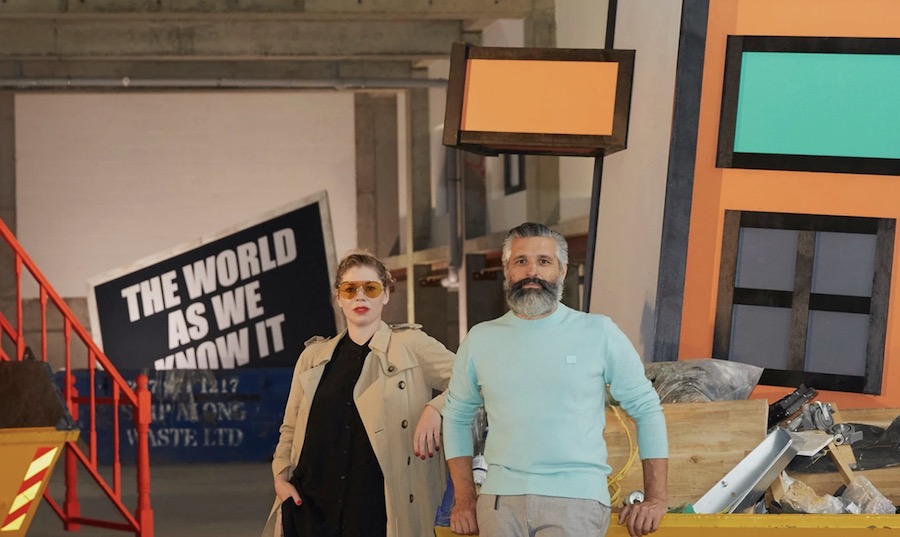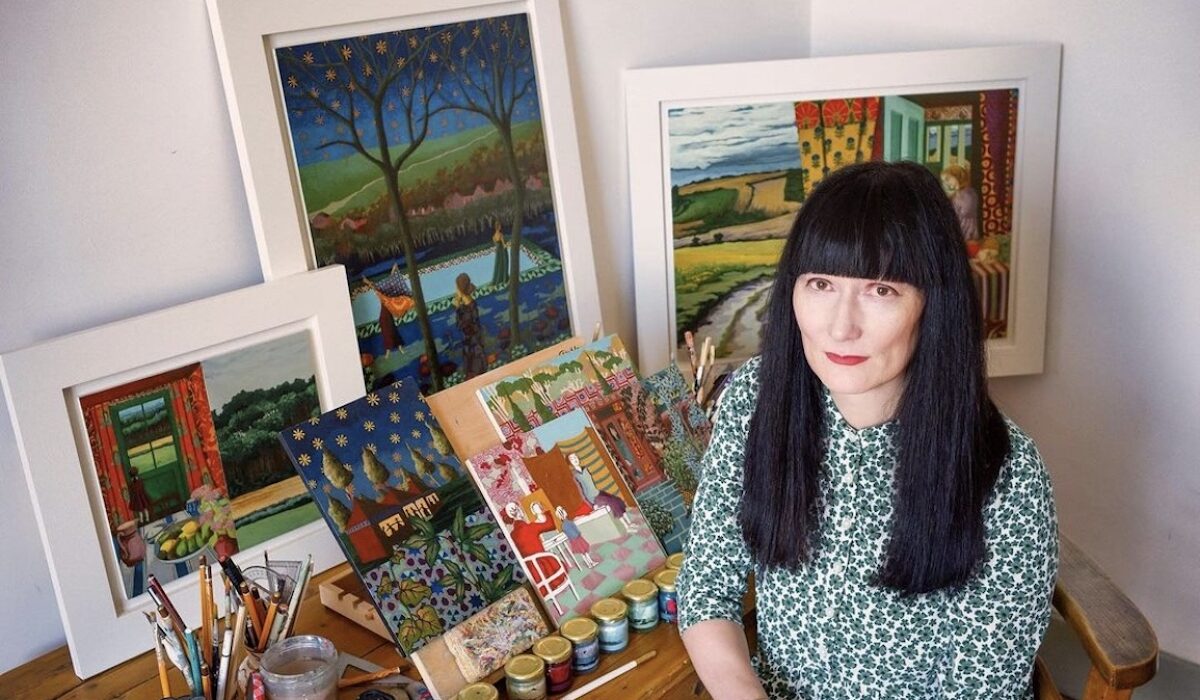Sussex, a tranquil and moody countryside of varying beauty, has long attracted artists and thinkers. Turner, Constable, Sickert and Ravilious painted its watery landscapes, chalk downs, genteel seasides and gritty ports: Chichester, Petworth, Brighton, and Newhaven. Eric Gill set up his craft workshops in Ditchling. Vanessa Bell, Virginia Woolf and Duncan Grant made Charleston, near Lewes, the country retreat of the Bloomsbury set, the epicentre of London’s avant-garde intellectual and cultural life.
This hasn’t changed. Charleston, now a gallery and museum, is still a Mecca of contemporary art, this year’s London Art Fair museum partner. Sussex, close enough to London to be accessible and in the metropolitan loop, distant enough to be affordable, still hosts a vibrant artist community. Brighton, with its free-wheeling bohemian metro-seaside-counterculture vibe, brims with creativity and talent.
Accessible and affordable could be a tagline for the Brighton-based artist and curating duo Baker and Borowski. It takes an original mind to see the artistic potential of a builders’ skip: in the case of Catherine Borowski and Lee Baker, two original minds. Skip Gallery, the vehicle for their curatorial activity, creates vagabond exhibitions in dumpster bins. Part protest against art market elitism, part low-cost public attention grabber, their first skip popped up in front of an East End London funeral parlour in 2017. Since then, their skips have materialised and multiplied, sometimes invited, sometimes not, in venues ranging from dockland warehouses to Selfridges and the Royal Society of Sculptors. International locations include shows in New York, Rotterdam, Mykonos, and Milan.

As curators, Baker and Borowski create informal spaces for emerging artists to show their wares to ordinary folk. Beyond their work, they have promoted the likes of the Turner Prize nominee David Shrigley, Gavin Turk, Maja Djordjevic and Sarah Maple. Inside its Arte Povera wrapping, the gallery’s rainbow offering ranges from pure whimsy through existential philosophy to severe social messaging. Its skips have hosted a public potty, a candy-coloured ice-cream parlour, a mobile library, an architect-designed bachelor pad, and – one of Baker and Borowski’s installations — an urban-regenerating paint-on-paper alternative to the Chelsea Flower show. Beyond its potted skip version, Graphic Rewilding is a guerilla counterattack against inner-city decay and brutalism conceived by Borowski and executed by Baker, whose giant stylised floral murals plant fantastical gardens on otherwise sterile walls.
As an artist, Borowski is conceptual, Baker painterly, immersed in Japanese aesthetic traditions, particularly the 18th-century plant and animal scroll paintings of Ito Jakuchu’s “Colourful Realm of Living Beings.” Held together by shared experiences and a commitment to democratising art, their collaboration is dialectical, its debates and tensions stretching their practices.
Outside his partnership with Borowski, Baker is currently working on a set of larger-than-life Iris studies, giant canvases covering the walls of the loft studio they rent for a peppercorn sum above a community art centre. They will be shown later this year at Helm Gallery in the North Laine art district, painted in tones of yellow, green and blue, in a style that echoes art nouveau and Takeshi Murakami’s super flat celestial flowers.
Around the corner from Helm, another North Laine venue, Enter Gallery, is showing photographs by Jessica van der Weert. Plugged into the dance music scene, van der Weert documents its big beasts at play. Her 2015 Hoxton Gallery exhibition “FlipSide”, reprised in part in the Enter Gallery show, was a tongue-in-cheek spoof of the off-stage lifestyles of the likes of Boy George, Carl Cox, DJ Fresh, Annie Mac or Goldie, to name a few. Since 2014, she has turned her lens on fellow Brighton resident Norman Cook, better known as the superstar musician, DJ and producer Fatboy Slim. The result, Fatboy Slim, 10 Years Photographing a Legend, is the core of the Enter show: Among its iconic images, a full face portrait, mouth gagged with a Mr Happy billiard ball, and Fatboy Slim in the Brighton Seagulls dressing room, near naked, chewing a cigar.
Quirky, colourful, capturing moments of self-deprecating irony and tensile energy, van der Weert’s images are not classical studio portraits. But nor are they as intimately spontaneous as they might seem. Formerly an assistant to the fashion and art photographer Nick Knight, Van der Weert is far removed from the paparazzi celebrity hunters firing off multiple shots to catch an unguarded moment. Each pose is pre-planned, sketched and framed like the storyboard for an animated cartoon. Locations are reconnoitred in advance and groomed into theatrical sets. It’s a method formed in the pre-digital age when film was expensive and van der Weert, an eight-year-old with her first Brownie camera, could only afford one monthly roll.
Beyond her focus on musical celebrities, her work has a more severe side. During the first Covid lockdown, she was granted unique access to NHS hospitals to memorialise workers on the front line of the crisis. Her portraits of the doctors, nurses and carers who battled the pandemic have been shown at the Royal College of Physicians in London, which has also worked with her on a series of portraits of doctors in Africa, part of a project to expand medical access there. “After 40 years of making pictures and telling stories, I feel more than ever that art has to have a purpose,” Van der Weert says.
The shamanic installation artist and painter Jim Sanders also believes his art must have a purpose. Adopting a holistic and all-absorbing lifestyle dedicated to his practice, Sanders has converted his terrace cottage studio on Brighton’s outer fringe into an immersive ‘Spirit House’. Foraging in nearby woodlands, he collects fossils, animal skeletons, ancient coins, skulls, bones, wooden debris, and other found objects that he assembles into sculptures and shrines. The walls of his home are lined from floor to ceiling with shredded canvas hangings painted in fetish colours, red, black and white, invoking sacred geometries and pagan symbols of worship. He holds open houses for mystic rituals of transcendent music and dance at auspicious times. His next performance will celebrate this month’s spring equinox on the weekend of March 23/24.
More mainstream and infused with a different sense of mystical spirituality, the painter Kate Montgomery ( Also Top Photo) tells stories of a parallel universe, dreamlike, timeless, peopled with female figures that seem almost in a state of suspended animation. A graduate of Oxford University’s Ruskin School of Art and the Royal College of Art, Montgomery keeps a copy of Owen Jones’s Grammar of Ornament on the shelf of her studio. Its influence is visible in the orderly, geometrical patterning of the gardens and interiors that often feature in the background of her figurative stories. Small in format, her paintings are jewels of colour and precise design, worked in a casein-based paint that glows with inner light. The overall effect combines the formal composition of Persian and Indian miniatures with strong story-telling reminiscent of Paula Rego, drawn from folk tales, legends, histories and family tales. “When I paint a picture, I want to return to it and find more layers of meaning, a sort of constant unfolding”, Montgomery told Artlyst in an interview.
In a different but, in some ways, similar universe invented by the Goldsmiths-trained artist Jo Lamb, wisdom is dispensed by a philosophical rabbit named Fluffy, mischievous Yokai spirits haunt Japanese forests and homemakers in a drowned mediaeval village are dab hands with plum jam.
Combining text with quasi-mythical figures and landscapes, Lamb conjures childhood worlds as dreamlike and free from the ordinary boundaries of space and time as Alice’s wonderland. Like her exegetic avatar Fluffy, born from a philosophical encounter with Joseph Beuys’ dead hare, Lamb is a cosmopolitan. After studying textile printing and fine art in London, she developed a vibrant colour palette and joyful graphic style during her post-graduate years in Africa. Now based in the Sussex county town of Lewes, she until recently divided her time between her imaginary worlds – visited with the financial support of an imaginary patron, the Scherzo Foundation– and the real world of Lewes Jail, where for 16 years she ran art classes for the prisoners.
Scherzo is Italian for Joke, and Lamb’s painting is playful, like Italian Comedia del Arte, using humour as a disguise for exploring deeper meanings. Newly returned from their imaginary voyage to Japan, hunting mythical monsters and the moon rabbit, Lamb, Fluffy and two artist friends recently completed a preliminary excavation of Slynde, the mediaeval village in the Sussex Downs drowned by the construction of a reservoir many years ago, now dried out again by climate change. Lamb’s paintings recover its lost history – its witches and pantomime horses, its wicked Earl and saintly Abbess Eleanor (descended from the ancient British Queen Boudica), its Slynde terriers bred to sniff out its magical and medicinal red truffles, its homemakers famed for their delicious plum jam.
Top Photo: Courtesy Kate Montgomery
Visit
Tags
Baker and Borowski, Jessica van der Weert, Jo Lamb, Kate Montgomery, Sussex Artists

